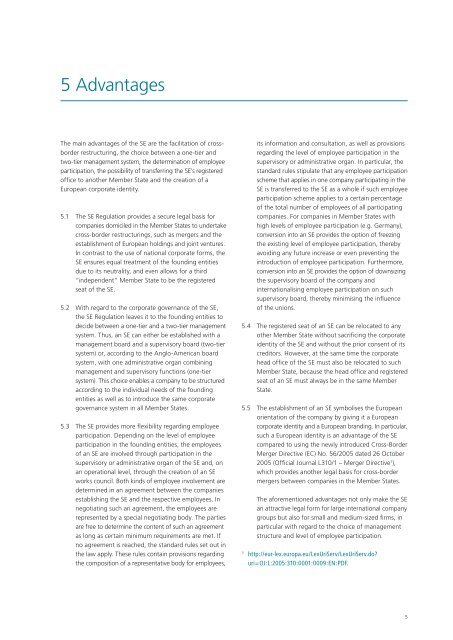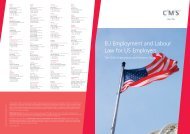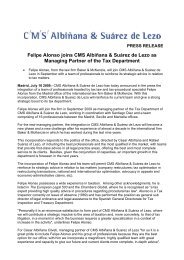Societas Europaea - CMS Legal
Societas Europaea - CMS Legal
Societas Europaea - CMS Legal
Create successful ePaper yourself
Turn your PDF publications into a flip-book with our unique Google optimized e-Paper software.
5 Advantages<br />
The main advantages of the SE are the facilitation of crossborder<br />
restructuring, the choice between a one-tier and<br />
two-tier management system, the determination of employee<br />
participation, the possibility of transferring the SE’s registered<br />
office to another Member State and the creation of a<br />
European corporate identity.<br />
5.1 The SE Regulation provides a secure legal basis for<br />
companies domiciled in the Member States to undertake<br />
cross-border restructurings, such as mergers and the<br />
establishment of European holdings and joint ventures.<br />
In contrast to the use of national corporate forms, the<br />
SE ensures equal treatment of the founding entities<br />
due to its neutrality, and even allows for a third<br />
“independent” Member State to be the registered<br />
seat of the SE.<br />
5.2 With regard to the corporate governance of the SE,<br />
the SE Regulation leaves it to the founding entities to<br />
decide between a one-tier and a two-tier management<br />
system. Thus, an SE can either be established with a<br />
management board and a supervisory board (two-tier<br />
system) or, according to the Anglo-American board<br />
system, with one administrative organ combining<br />
management and supervisory functions (one-tier<br />
system). This choice enables a company to be structured<br />
according to the individual needs of the founding<br />
entities as well as to introduce the same corporate<br />
governance system in all Member States.<br />
5.3 The SE provides more flexibility regarding employee<br />
participation. Depending on the level of employee<br />
participation in the founding entities, the employees<br />
of an SE are involved through participation in the<br />
supervisory or administrative organ of the SE and, on<br />
an operational level, through the creation of an SE<br />
works council. Both kinds of employee involvement are<br />
determined in an agreement between the companies<br />
establishing the SE and the respective employees. In<br />
negotiating such an agreement, the employees are<br />
represented by a special negotiating body. The parties<br />
are free to determine the content of such an agreement<br />
as long as certain minimum requirements are met. If<br />
no agreement is reached, the standard rules set out in<br />
the law apply. These rules contain provisions regarding<br />
the composition of a representative body for employees,<br />
its information and consultation, as well as provisions<br />
regarding the level of employee participation in the<br />
supervisory or administrative organ. In particular, the<br />
standard rules stipulate that any employee participation<br />
scheme that applies in one company participating in the<br />
SE is transferred to the SE as a whole if such employee<br />
participation scheme applies to a certain percentage<br />
of the total number of employees of all participating<br />
companies. For companies in Member States with<br />
high levels of employee participation (e.g. Germany),<br />
conversion into an SE provides the option of freezing<br />
the existing level of employee participation, thereby<br />
avoiding any future increase or even preventing the<br />
introduction of employee participation. Furthermore,<br />
conversion into an SE provides the option of downsizing<br />
the supervisory board of the company and<br />
internationalising employee participation on such<br />
supervisory board, thereby minimising the influence<br />
of the unions.<br />
5.4 The registered seat of an SE can be relocated to any<br />
other Member State without sacrificing the corporate<br />
identity of the SE and without the prior consent of its<br />
creditors. However, at the same time the corporate<br />
head office of the SE must also be relocated to such<br />
Member State, because the head office and registered<br />
seat of an SE must always be in the same Member<br />
State.<br />
5.5 The establishment of an SE symbolises the European<br />
orientation of the company by giving it a European<br />
corporate identity and a European branding. In particular,<br />
such a European identity is an advantage of the SE<br />
compared to using the newly introduced Cross-Border<br />
Merger Directive (EC) No. 56/2005 dated 26 October<br />
2005 (Official Journal L310/1 – Merger Directive 3 ),<br />
which provides another legal basis for cross-border<br />
mergers between companies in the Member States.<br />
The aforementioned advantages not only make the SE<br />
an attractive legal form for large international company<br />
groups but also for small and medium-sized firms, in<br />
particular with regard to the choice of management<br />
structure and level of employee participation.<br />
3 http://eur-lex.europa.eu/LexUriServ/LexUriServ.do?<br />
uri=OJ:L:2005:310:0001:0009:EN:PDF.<br />
5





